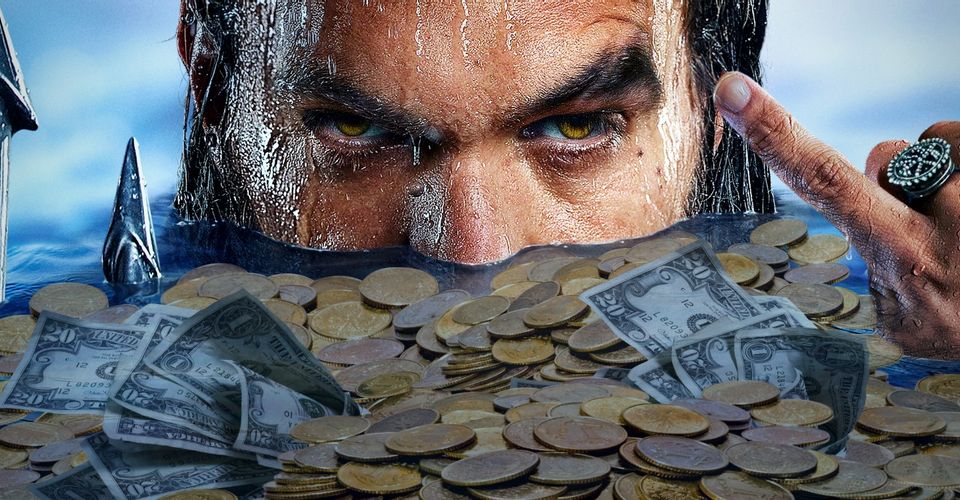Aquaman’s Box Office Success Was Better Than Anybody (Even DC) Expected

Aquaman was a much bigger box office hit than anybody anticipated. At this point last year, the DC Extended Universe was in bad shape, left reeling from the critical and commercial disaster that was Justice League. The long-awaited team-up film was marred by a rocky production (which has been extensively covered already) and ended its theatrical run as the lowest-grossing entry in the young franchise. Whatever goodwill was generated by Wonder Woman was essentially thrown away, leaving many people to contemplate what the future would hold for DC.
Justice League’s underwhelming performance brought about substantial behind-the-scenes changes at WB and considerable doubt Henry Cavill’s Superman and Ben Affleck’s Batman have a place on the film slate. One project that was virtually unaffected by the drama was James Wan’s Aquaman, which had wrapped filming months before Justice League opened in theaters. Many were curious to see how Arthur Curry’s solo film would fare, and it’s safe to say the film exceeded even the rosiest of expectations.
Related: Why Aquaman Is The First DCEU Film To $1 Billion
Aquaman Is The Highest-Grossing DCEU Film

Understandably, WB chose to kick off their shared universe by featuring characters the general public was overtly familiar with. Superman origin story Man of Steel was first out of the gate, and in the next film, Kal-El took on Bruce Wayne. However, the results were hardly what the studio was looking for. Critical and audience reactions were decidedly mixed, as several people found it difficult to not compare these latest versions of pop culture icons to what came before. The word-of-mouth seemed to have some impact on the box office; Batman V Superman suffered a massive 69.1 percent drop in its second weekend and came up well short of $1 billion. WB and DC had more success when introducing characters to filmgoing audiences.
Wonder Woman is a strong example of that point ($412.5 million domestic; $821.8 million worldwide), but Aquaman is an even better one. Believe it or not, the one-time superhero punching bag headlined the first DCEU film to cross the $1 billion plateau, even as it played during a crowded holiday season that included several other high-profile titles like Bumblebee, Mary Poppins Returns, and Spider-Man: Into the Spider-Verse. Riding waves of positive buzz, Aquaman emerged as the go-to film for general viewers over Christmas, filling the void left by Star Wars (which had called December home since 2015). While Aquaman didn’t receive reviews as glowing as Wonder Woman, many were in agreement it was a visually-stunning and fun comic book adaptation that should be seen on the big screen. For those reasons, it won three consecutive weekends before its reign was ended by The Upside.
Related: How Aquaman Corrected The DCEU’s Marketing Mistakes

Where Aquaman truly thrived was overseas, as $733.6 million of its $1 billion total comes from international markets. In particular, the film was a massive hit in China, becoming WB’s highest-grossing release in the country and earning a rare extended run in their theaters. The list of comic book adaptations Aquaman has outgrossed globally is very impressive, and it needed all the help it can get from foreign territories. Domestically, the film’s performance was fine, but nothing to write home about. Debuting with $67.8 million in the States, Aquaman’s current domestic total stands at $289.3 million. That’s still the second-lowest figure in the DCEU (though it should pass Man of Steel soon). It might be able to climb up the list during the tail end of its run (Suicide Squad’s mark of $325.1 million is in reach), but now Aquaman has to deal with Glass becoming the hot movie of the week. It’ll be interesting to see what happens from here.
That being said, it doesn’t matter to WB where the money comes from as long as they make a lot of it. $1 billion is still $1 billion, and the studio turned a very healthy profit from their investment. Aquaman was budgeted at around $160 million, meaning its break even point was roughly $320 million. Obviously, the film greatly surpassed that and is in the black for a cool $680 million before we even factor in ancillary revenue like home media sales. If Aquaman stopped earning money at the box office today, WB would still be able to make four Aquamans and still have a little side cash to spare. There’s no overstating that’s an incredible accomplishment for this movie, which only a handful of years ago seemed like an unlikely proposition. It’s amazing enough Aquaman was made, but to see it be this monumentally successful gives WB plenty of reasons to celebrate.
Page 2: Lessons WB Can Learn From Aquaman’s Box Office
- Shazam! (2019)Release date: Apr 05, 2019
- Joker (2019)Release date: Oct 04, 2019
- Birds of Prey (And the Fantabulous Emancipation of One Harley Quinn) (2020)Release date: Feb 07, 2020
- Wonder Woman 1984 (2020)Release date: Dec 25, 2020
1
2
About The Author


















